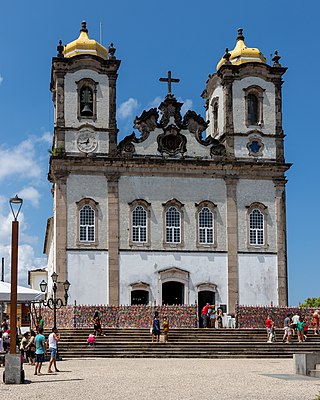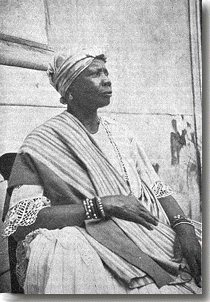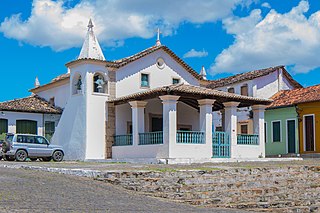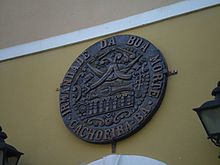
Umbanda is a religion that emerged in Rio de Janeiro, Brazil in the 1920s. Deriving largely from Spiritism, it also combines elements from Afro-Brazilian traditions like Candomblé as well as Roman Catholicism. There is no central authority in control of Umbanda, which is organized around autonomous places of worship termed centros or terreiros, the followers of which are called Umbandistas. The religion is broadly divided between White Umbanda, which is closer to Spiritism, and Africanized Umbanda, which is closer to Candomblé.

Samba is a lively dance of Afro-Brazilian origin in 2/4(2 by 4) time danced to samba music.

Candomblé is an African diasporic religion that developed in Brazil during the 19th century. It arose through a process of syncretism between several of the traditional religions of West Africa, especially those of the Yoruba, Bantu, Igbo people and Gbe, coupled with influences from the Roman Catholic form of Christianity. There is no central authority in control of Candomblé, which is organized around autonomous terreiros (houses).

The predominant religion in Brazil is Christianity, with Catholicism being its largest denomination.

Candomblé Ketu is the largest and most influential branch (nation) of Candomblé, a religion practiced primarily in Brazil. The word Candomblé means "ritual dancing or gather in honor of gods" and Ketu is the name of the Ketu region of Benin. Its liturgical language, known as yorubá or Nagô, is a dialect of Yoruba. Candomblé Ketu developed in the early 19th century and gained great importance to Brazilian heritage in the 20th century.

Axé is a popular music genre originated in Salvador, Bahia, Brazil in the 1980s, fusing different Afro-Caribbean genres, such as marcha, reggae, and calypso. It also includes influences of Brazilian music such as frevo, forró and carixada. The word Axé comes from the Yoruba term àṣẹ, meaning "soul, light, spirit or good vibrations". Axé is present in the Candomblé religion, as "the imagined spiritual power and energy bestowed upon practitioners by the pantheon of orixás". It also has ties with the Roman Catholic Church and the Lenten season, which represents the roots of Bahian Carnival.

Santo Amaro, also known as Santo Amaro da Purificação, is a municipality in the state of Bahia in Brazil. The population is 60,131 in an area of 492.9 square kilometres (190.3 sq mi). It is located in the metropolitan area of Salvador. Santo Amaro is located approximately 73 kilometres (45 mi) from the city of Salvador. Santo Amaro was home to numerous indigenous peoples until the arrival of the Portuguese, who developed the region for sugarcane production. Santo Amaro is now noted for its numerous historic structures. The city is also a center of Candomblé, having more than 60 terreiros, or temples of the religion.

Cachoeira is an inland municipality of Bahia, Brazil, on the Paraguaçu River. The town exports sugar, cotton, and tobacco and is a thriving commercial and industrial centre.

The Church of Our Lord of Bonfim is the most famous of the Catholic churches of Salvador, in the State of Bahia, Brazil. It was built in the 18th century on the only line of hills in the Itapagipe Peninsula, in the lower town of Salvador. The church is the subject of intense religious devotion by the people of Salvador and is the site of a famous celebration held every year in January, the Festa do Senhor do Bonfim. The church is the cathedral of the Roman Catholic Diocese of Bonfim. The church is noted for the Festa do Bonfim, held annually the second Thursday after Three Kings Day. The festival combines elements of both Catholicism and Candomblé. It was listed as a historic structure by the National Historic and Artistic Heritage Institute in 1938.
This article details the history of the Catholic Church in Brazil from the colonial era until the modern era. The Federative Republic of Brazil is the largest country in South America. It is the world's fifth largest country, both by geographical area and by population with over 201 million people. Catholicism is the country's predominant faith with approximately 64.6% of the population identifying as a member of the religion. Brazil has the world's largest Catholic population.

Yemọja is the major water spirit from the Yoruba religion. She is the mother of all Orishas. She is also the mother of humanity. She is an orisha, in this case patron spirit of rivers, particularly the Ogun River in Nigeria, and oceans in Cuban and Brazilian orisa religions. She is often syncretized with either Our Lady of Regla in the Afro-Cuban diaspora or various other Virgin Mary figures of the Catholic Church, a practice that emerged during the era of the Trans-Atlantic slave trade. Yemọja is said to be motherly and strongly protective, and to care deeply for all her children, comforting them and cleansing them of sorrow. She is said to be able to cure infertility in women, and cowrie shells represent her wealth. She does not easily lose her temper, but when angered she can be quite destructive and violent, as the flood waters of turbulent rivers. Some of the priests of Yemọja believe that she used her fresh water to help Ọbàtálá in the molding of human beings out of clay.

Eugênia Anna Santos was a Brazilian Iyalorixá. She founded the candomblé Ilê Axé Opó Afonjá in Salvador, now considered a National Historic Landmark, and in Rio de Janeiro.

The Chapel of Our Lady of Help is a 17th-century Roman Catholic church located in Cachoeira, Bahia, Brazil. It is the first church built in Cachoeira as part of the Adorno family sugar plantation and is home to the Brotherhood of Our Lady of Help. The church is likewise dedicated to Our Lady of Help. The chapel attracts a large number of pilgrims devoted to Our Lady of Help. The chapel was listed as a historic structure by National Institute of Historic and Artistic Heritage (IPHAN) in 1939.

The Church of the Third Order of Our Lady of the Rosary of the Black People is an 18th-century Roman Catholic church in Salvador, Bahia, Brazil. Construction of the church took almost 100 years. It is dedicated to Our Lady of the Rosary and belongs to the Archdiocese of São Salvador da Bahia. The church was listed as a historic structure by National Institute of Historic and Artistic Heritage (IPHAN) in 1938 and is part of the Historic Center of Salvador UNESCO World Heritage Site.

The Church of the Seminary of Belém ) is a church and former school in Cachoeira, Bahia, Brazil. The seminary was founded in 1686 by the Jesuits and was the order's first school in Brazil outside of the city of Salvador. The seminary eventually was home to eight priests and between 100 and 140 students. The Jesuits held an equal number of slaves of African origin at the seminary. The seminary complex fell into ruins after the expulsion of the Jesuits from Brazil in 1759. The church is the only remaining structure of the seminary and is dedicated to Our Lady of Bethlehem. It retains many elements of both 17th-century Portuguese colonial church architecture. The Church of the Seminary of Belém was listed as a historic structure by the National Historic and Artistic Heritage Institute in 2005.

The Royal and Venerable Confraternity of the Most Blessed Sacrament of Mafra, alternatively, the Royal and Venerable Brotherhood of the Most Blessed Sacrament of Mafra, is a public association of faithful of the Catholic Church, canonically established in the Basilica of Our Lady and Saint Anthony of Mafra, Portugal.

Terreiro Loba Nekun Filho, also spelled as Terreiro Lobanekum Filho, or Casa de Mae Lira, is a Candomblé terreiro in Cachoeira, Bahia, Brazil. It was founded by Amazilia Matias da Conceição (1906-1997), better known as Mãe Lira de Iemanjá Ogunté. Unlike other terreiros that cover large urban or rural spaces, Terreiro Loba Nekun Filho is located in a long, narrow single-story row house. The terreiro is protected as a historic structure by the state of Bahia.

Afro-Brazilian culture is the combination of cultural manifestations in Brazil that have suffered some influence from African culture since colonial times until the present day. Most of Africa's culture reached Brazil through the transatlantic slave trade, where it was also influenced by European and indigenous cultures, which means that characteristics of African origin in Brazilian culture are generally mixed with other cultural references.
The Church of Our Lady of the Good Death is a 19th-century Roman Catholic church in Cuiabá, Mato Grosso, Brazil. The church is dedicated to Our Lady of Help and belongs to the Roman Catholic Archdiocese of Cuiabá. The church was built in a simple, Portuguese colonial style, likely around 1810, by the Brotherhood of Our Lady of the Good Death. Unlike other colonial and Imperial-period architecture in Cuiaba, its appearance remains unchanged from its initial construction in the 19th century. The festival day of Our Lady of Glory and Good Death is celebrated on August 15, a tradition continued from the founding of the church. It is now managed by the Franciscans, who celebrate a feast day dedicated to Saint Anthony on June 13th.

The Recôncavo Baiano is a geographical region located in the Brazilian state of Bahia that covers the inland area surrounding the Bay of All Saints and the Metropolitan Region of Salvador. However, the expression is not constantly used to refer to Salvador.


















